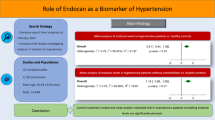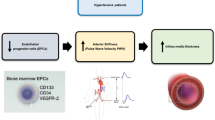Abstract
Hypertensive patients are at particular risk of cardiovascular complications, possibly related to endothelial damage or dysfunction, or to abnormal angiogenesis. The aim of this study was to compare the risk conferred by white coat hypertension (WCH) vs sustained hypertension in the development of the endothelial dysfunction and abnormal angiogenesis by evaluating nitric oxide (NO=NO2+NO3), endothelin-1 (ET-1), vascular endothelial growth factor (VEGF), and E-selectin levels in plasma. The study group included 102 subjects, 34 with WCH (17 male and 17 female patients) aged 49±11 years, 34 sustained hypertensives (HT) (15 male and 19 female patients) aged 47±11 years and 34 normotensive control subjects (NT) (16 male and 18 female patients) aged 48±10 years. WCH was defined as clinical hypertension and daytime ambulatory blood pressure less than 135/85 mmHg. The subjects were matched for age, gender, body mass index and the patients with smoking habit, dyslipidaemia, and diabetes mellitus were excluded from the study. The NO, ET-1, VEGF and E-selectin levels were analysed by ELISA technique. The WCH subjects had significantly higher levels of NO than the HT (41.68±2.23 vs 32.18±2.68 μmol/l; P<0.001) and significantly lower values than the NT (48.24±4.29 μmol/l; P<0.001). ET-1 levels of the WCH group were significantly higher than the NT (8.10±0.92 vs 5.95±0.26 ng/ml; P<0.001) and significantly lower than the HT (11.46±0.59 ng/ml; P<0.001). Considering with VEGF, the WCH group had significantly higher levels than the NT (195.88±11.84 vs 146.26±18.67 pg/ml; P<0.001), but the difference from the HT group was not significant (203.35±7.48 pg/ml; P=0.062). E-selectin in the WCH group was significantly lower than the HT (4.77±0.52 vs 8.49±2.85; P<0.001), but the difference from the NT group was not significant (3.86±0.67; P=0.077). Our data demonstrate that WCH is associated with endothelial dysfunction and abnormal angiogenesis. The degree of these changes is not as severe as observed in hypertensive population.
This is a preview of subscription content, access via your institution
Access options
Subscribe to this journal
Receive 12 digital issues and online access to articles
$119.00 per year
only $9.92 per issue
Buy this article
- Purchase on Springer Link
- Instant access to full article PDF
Prices may be subject to local taxes which are calculated during checkout
Similar content being viewed by others
References
Felmeden DC et al. Endothelial damage and angiogenesis in hypertensive patients: relationship to cardiovascular risk factors and risk factor management. Am J Hypertens 2003; 16: 11–20.
Celermajer DS . Endothelial dysfunction: does it matter? Is it reversible? J Am Cardiol 1997; 30: 801–809.
Blann AD, McCollum CN . von Willebrand factor, endothelial cell damage and atherosclerosis. Eur J Vasc Surg 1994; 8: 10–15.
Blann AD, Lip GYH . The endothelium in atherothrombotic disease: assessment of function, mechanisms and clinical implications. Blood Coagul Fibrinolys 1998; 9: 297–306.
Soma J et al. Hemodynamics in white coat hypertension compared to ambulatory hypertension and normotension. Am J Hypertens 1996; 9: 1090–1098.
Pickering TG et al. How common is white coat hypertension. JAMA 1988; 259: 225–228.
White WB et al. Average daily blood pressure, not office blood pressure, determines cardiac function in patients with hypertension. JAMA 1989; 261: 873–877.
Cardillo C et al. Psychological reactivity and cardiac end organ changes in white coat hypertension. Hypertension 1993; 21: 836–844.
Hoegholm A et al. Microalbuminuria in 411 untreated individuals with established hypertension, white coat hypertension and normotension. Hypertension 1994; 24: 101–105.
Björklund K et al. Different metabolic predictors of white-coat and sustained hypertension over a 20-year follow up. Circulation 2002; 106: 63 (Abstract).
Julius S et al. ‘White coat’. versus ‘sustained’ borderline hypertension in Tecimseh, Michigan. Hypertension 1990; 16: 617–623.
Weber MA et al. Diagnosis of mild hypertension by ambulatory blood pressure monitoring. Circulation 1994; 90: 2291–2298.
Pierdomenico SD et al. Endothelial function in sustained and white coat hypertension. Am J Hypertens 2002; 15: 946–952.
Hlubocka Z et al. Circulating intercellular cell adhesion molecule-1, Endothelin-1 and von Willebrand factor-markers of endothelial dysfunction in uncomplicated essential hypertension: the effect of treatment with ACE inhibitors. J Hum Hypertens 2002; 16: 557–562.
Bjorklund K et al. Isolated ambulatory hypertension predicts cardiovascular morbidity in elderly men. Circulation 2003; 107: 1297–1302.
Bjorklund K et al. Different metabolic predictors of white-coat and sustained hypertension over a 20-year follow-up period: a population-based study of elderly men. Circulation 2002; 106: 63–68.
Gustavsen PH, Hoegholm A, Bang L, Kristensen KS . White coat hypertension is a cardiovascular risk factor: a 10-year follow-up study. J Hum Hypertens 2003; 17: 811–817.
Vaindirlis I et al. ‘White coat hypertension’ in adolescents: increased values of urinary cortisol and endothelin. J Pediatr 2000; 136: 359–364.
American Society of Hypertension. Recommendations for routine blood pressure measurement by indirect cuff sphygmomanometry. Am J Hypertens 1992; 5: 207–209.
O'Brien E et al. On behalf of the European Society of Hypertension Working Group on Blood Pressure Monitoring. Blood pressure measuring devices: recommendations of the European Society of Hypertension. BMJ 2001; 322: 531–536.
O'Brien E et al. Use and interpretation of ambulatory blood pressure monitoring: recommendations of the British Hypertension Society. BMJ 2000; 320: 1128–1134.
Green LC et al. Analysis of nitrate, nitrite and 15N nitrate in biological fluids. Anal Biochem 1982; 126: 131–138.
Kosmala W . Endothelial dysfunction in hypertension—clinical implications. Pol Merkuriusz Lek 2002; 12: 333–335.
Kinlay S et al. Endothelium-derived nitric oxide regulates arterial elasticity in human arteries in vivo. Hypertension 2001; 38: 1049–1053.
Moriel P et al. Nitric oxide, cholesterol oxides and endothelium-dependent vasodilation in plasma of patients with essential hypertension. Braz J Med Biol Res 2002; 35: 1301–1309.
Gomez CR et al. Noninvasive study of endothelial function in white coat hypertension. Hypertension 2002; 40: 304–309.
Zanella MT, Plavnik FL, Rubbo H, Abdalla DSP . Nitric oxide, cholesterol oxides, and endothelium dependent vasodilation in plasma of patients with essential hypertension. J Braz Med Biol Res 2002; 35: 1301–1309.
Burnstoc. Release of vasoactive substances from endothelial cells by shear stress and purinergic mechanosensory transduction. J Anat 1999; 94: 335–342.
Cardillo C et al. Selective defect in nitric oxide synthesis may explain the impaired endothelium-dependent vasodilatation in patients with hypertension. Circulation 1998; 97: 851–856.
Agapitov AV, Haynes WG . Role of endothelin in cardiovascular disease. J Renin Angiotensin Aldosterone Syst 2002; 3: 1–15 (Abstract).
De Caterina R et al. Soluble e-selectin in essential hypertension: a correlate of vascular structural changes. Am J Hypertens 2001; 14: 259–266 (Abstract).
De Caterina R, Gimbrone Jr MA . Leukocyte-endothelial interactions and the pathogenesis of atherosclerosis. In Kristensen SD, Schmidt EB, De Caterina R, Endres S (eds). n-3 Fatty Acids: Prevention and Treatment in Vascular Disease. Springer: London, 1995 pp 10–24.
Blann AD, Tse W, Maxwell SJR, Waite MA . Increased levels of the soluble adhesion molecule E-selectin in essential hypertension. J Hypertens 1994; 12: 925–928.
Blann AD, McCollum CN . von Willebrand factor, endothelial cell damage and atherosclerosis. Eur J Vasc Surg 1994; 8: 10–15.
Blann AD, Waite MA . von Willebrand factor and soluble E-selectin in hypertension: influence of treatment and value in predicting the progression of atherosclerosis. Coron Artery Dis 1995; 7: 143–147.
Roldan V, Marin F, Lip GY, Blann AD . Soluble E-selectin in cardiovascular disease and its risk factors. A review of the literature. Thromb Haemost 2003; 90: 1007–1020.
Verhaar MC et al. Progressive vascular damage in hypertension is associated with increased levels of circulating P-selectin. J Hypertens 1998; 16: 45–50.
Ferri C et al. Early activation of vascular endothelium in nonobese, nondiabetic essential hypertensive patients with multiple metabolic abnormalities. Diabetes 1998; 47: 660–667.
Kuroda YT et al. Vascular cell adhesion molecule-1 as a biochemical marker of left ventricular mass in the patients with hypertension. Am J Hypertens 2001; 14: 868–872.
Karter Y et al. Endothelial dysfunction in sustained and white coat hypertension. Am J Hypertens 2003; 16: 852.
Hutchins PM, Darnell AE . Observation of a decreased number of small arterioles in spontaneous hypertensive rats. Circ Res 1974; 34/35(Suppl): 161–165 (Abstract).
Sullivan JM, Prewitt RL, Josephs JA . Attenuation of the microcirculation in young patients with high-output borderline hypertension. Hypertension 1983; 5: 844–851 (Abstract).
Struijker Boudier HA et al. The microcirculation in hypertension. J Hypertens 1992; 10(Suppl 7): 147.
O'Brien ER et al. Angiogenesis in human coronary artery plaques. Am J Pathol 1994; 145: 883–894.
Lee SH et al. Early expression of angiogenesis factors in acute myocardial ischaemia and infarction. N Engl J Med 2000; 342: 626–633.
Belgore FM et al. Plasma levels of vascular endothelial growth factor and its soluble receptor (SFlt-1) in essential hypertension. Am J Cardiol 2001; 87: 805–807 A9.
Author information
Authors and Affiliations
Corresponding author
Rights and permissions
About this article
Cite this article
Karter, Y., Aydın, S., Curgunlu, A. et al. Endothelium and angiogenesis in white coat hypertension. J Hum Hypertens 18, 809–814 (2004). https://doi.org/10.1038/sj.jhh.1001752
Received:
Accepted:
Published:
Issue Date:
DOI: https://doi.org/10.1038/sj.jhh.1001752



